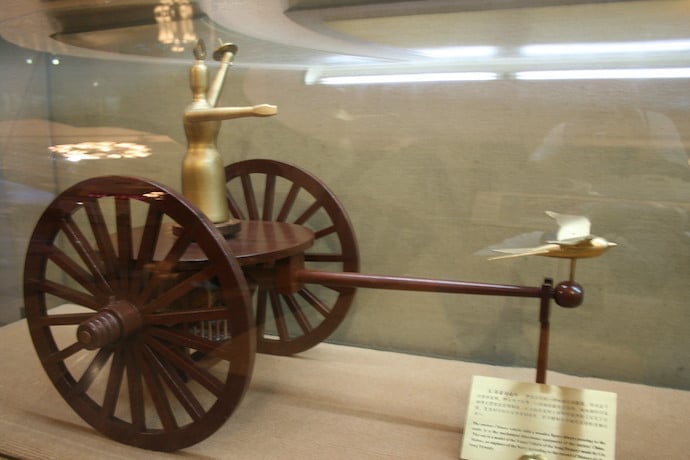Without a compass or phone, how in the world would we know which way to go? At night, we have the North Star to orient us. But what if it was in the middle of the day?
Before the compass was invented, ancient civilizations had clever ways to keep track of where they were going. None were quite so novel as the South-Pointing Chariot, which helped the ancient Chinese stay on course.
Directional Dude
The design of the South-Pointing Chariot is a bit sillier than you might imagine. It was a small cart that carried a wooden statue of a pointing man on the back. The idea was that the man would always point Southward, no matter where the cart went.
Again, this was long before compasses, so the pointing man didn’t use the Earth’s magnetic field. Instead, there was another little bit of engineering ingenuity behind how the South-Pointing Chariot worked.
Let’s start with a simple example. Say you and a friend wanted to jog alongside each other. If you were both jogging down a street and both maintained the same speed, it would be simple to stay together.
Things get a little more complicated, however, when you both turn a 90-degree corner. If you are on the inside (close to the curb), your friend would have to pick up speed to stay alongside you. If he maintained the same speed, you’d leave him behind.
The reverse is true if you were on the outside; you would need to pick up the pace to stay alongside your friend. This is because the person on the outside has to cover more ground in the same amount of time as the person on the inside.
Taking Turns
The same is true when something with wheels makes a turn. The wheels on the ‘outside’ of the turn spin faster than those on the ‘inside’? The ancient Chinese could use this knowledge to make their South-Pointing Chariot know where to point.
First of all, they would set the man up so that he was definitely pointing Southward. Then, they took the cart for a ride. Within the cart was a drive shaft specifically set up to measure the difference between how fast each wheel was turning. If they were turning at the same speed, that meant the cart was going straight, so nothing had to be done.
The moment there was a difference in wheel speeds, that meant the cart was taking a turn, and the cogs in the drive shaft turned to automatically adjust the pointing man so he continued pointing South, no matter how many times they turned. The cogs acted as a kind of calculator to measure how much to turn the pointing man.
As you might expect, a system like this would need to be very accurate to work properly. If the system detected one wheel was even slightly faster than the other, the pointing man would slowly veer off course.
Though the logic was sound, some historians believe that the South-Pointing Chariot wasn’t used for long distances. The longer you go, the more errors could potentially creep into the mechanism, and the more skewed the pointing man would be. As a result, some historians believe that the chariot wasn’t used for critical tasks at all but, instead, was a way to impress tourists with the culture’s engineering skills.
With modern technology, we no longer need little wooden men pointing us where we need to go. But this ancient method does show that there is more than one way for a machine to lead us in the right direction.
Learn More
South Pointing Chariot
https://en.wikipedia.org/wiki/South-pointing_chariot
South Pointing Chariot Explained
South Pointing Chariot: Ancient Invention
The South Pointing Chariot
https://www.futilitycloset.com/2019/11/23/the-south-pointing-chariot/
South Pointing Chariot
https://www.wikiwand.com/en/South-pointing_chariot

